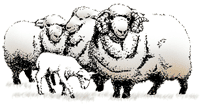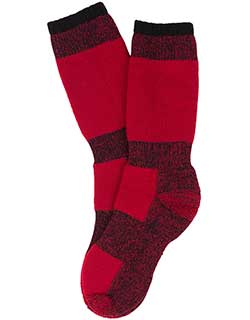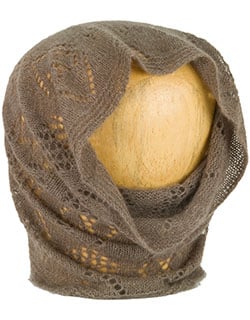Discover the Warmth of Wool

Wool's unique properties, including providing great insulation even when wet, have long made it a material of choice for outdoor clothing. Wool has been used by man from early times. Explorers such as Ernest Shackleton, Edmund Hillary and Roald Amundsen used layers of wool clothing to protect them under arduous conditions during their journeys. We are pleased to offer a range of quality woolens, from Qiviut Caps to J.B. Field's Socks to Devold's Islender Sweater. We invite you to browse through our woolens, or read on for more information about wool.
Wool is a natural insulator, grown by sheep and other animals. Sheep's wool is the principle wool used by man and discussed here, although alpaca, camel, goat, rabbit, possum and musk ox (qiviut) woolens are available.
Wool fibers consist of an inner core made of protein, which is covered by overlapping scales. The protein core will absorb up to 30% of its weight in moisture without becoming damp or clammy. The scales are hard, reducing wear on the fibers, and repel liquid water. The fibers are strong and elastic, and are usually wavy, or crimped. Wool also contains lanolin, a natural water-repellant grease. Wool on the sheep, or its fleece, protects the animal from the wet and cold by first turning away rain and water. The crimp of the wool produces insulating air spaces within the fleece, which reduce the flow of heat. The air near the skin is kept dry, and so a better insulator, by the core protein absorbing moisture from this trapped air, and passing it towards the outside of the fleece. The elasticity and strength of the fibers allow movement of the fleece without losing the air spaces or breaking the fibers. The scales besides repelling liquid water, help keep the fleece clean, since their outer ends all point in the direction away from the skin, and so with the movement of the fleece tend to push any dirt away from the skin.
Wool has a wide comfort range, essential for sheep and a unique and very helpful feature in outdoor garments. This can be explained by the way perspiration is removed from the skin layer and released from the outer surface of the wool. Perspiration is released by the skin, and cools the skin as it is released. When perspiration is absorbed by the wool fiber there is a heat of reaction which counters the cooling effect at the skin level. Because of the temperature gradient between the warm skin and the colder exterior of the wool garment, the moisture from perspiration migrates towards the outer surface of the wool, and there evaporates into the ambient air. The insulating value of the wool fleece or fabric is determined largely by the pockets of air trapped within the fabric. The amount of water vapor in the air within the wool fabric is a function of the temperature and the amount of water in the fibers, and affects the heat conductivity of this air. All else being equal, when the amount of activity or the ambient temperature increases the body perspires more, the heat conductivity of the air trapped in the wool fabric increases, and the insulating value of the wool decreases. Thus wool clothing not only keeps the skin dry and warm, but also adjusts its degree of insulation to some degree to suit the amount of activity and external temperature.
Wool is not uniform among all sheep. Sheep live in a wide variety of climates and conditions, and develop their wool to suit the conditions under which they live. Further, sheep have been domesticated for many years, and domestic sheep have been bred selectively to produce further variety in their wool. Today there are coarse wools for carpets, soft fine wools for undergarments, highly crimped wools for bulky woolen yarns, wools with very long fibers for strong fine worsted yarns - a wide range from which the textile manufacturers can choose for a specific product.
Merino wool is a very long staple, very fine wool from the Merino sheep. Merino sheep have been bred in Australia to produce extremely fine wool. The wool can also be treated to make it fully washable and tumble dryable without losing its great qualities.
Merino wool, particularly when twisted into a worsted yarn, is smooth to the skin. The fine fibers are soft, and the long staple gives fewer ends, reducing any irritation from loose ends.
Wool has long been used by people as clothing, blankets or furnishings, either as fleece or separated from the skin and made into textiles. Additional properties of wool enhance the value of wool in textiles. Wool is fire-resistant, and will not support a flame, an important property in furnishings and some clothing. It does not melt when heated, a significant factor in reducing the severity of burns from fires. It has a low tendency to collect static electricity, reducing stray electrostatic shocks, clinging of garments, and attraction of dust and lint. Reactive proteins in the core take dye well, and hold the color. The scales on the fibers diffuse the filtered light to yield softer colors.
Processing of wool for textiles has been well developed to take advantage of the various properties of wool and the various types of wool available. At the simplest level wool may be coarsely felted, as in the felt covers for yurts in Mongolia. This felting is possible because of the wool fiber scales, which, when separated from the skin and facing opposing directions, catch on to one another, permitting the felting of wool into a strong mass of fibers held together by the interlocking action of the scales. Wool may be spun into yarn from the fleece and either knitted or woven into textiles as fisherman knits from Ireland or Navajo blankets. Wool may be thoroughly cleaned and mixed so that the fibers are not preferentially oriented relative to nearby fibers and then spun into woolen yarn, that is a bulky yarn where the crimp of the fibers is developing the maximum amount of insulating air space. Alternatively the yarn may be combed before spinning in order to align the fibers together to form a dense worsted yarn relatively low on air space. These yarns may be made of very fine soft wool fibers or of thick stiff fibers.
The knitting or weaving processes are also versatile. Knitting can be tight or loose, and can use thick or thin yarn. It can be simple, to form a relatively flat surface, or fancy, to form a more textured surface, or it can be more complex to form a layered fabric or other special effects. Weaving can be a simple over-one, under-one weave, or complex to form special effects. Knitted or woven fabrics can also be felted by working them in hot water, forming boiled wool in the case of knitted fabrics, and mackinaw or melton cloth in the case of woven fabrics. Thus between the different wools available and the range of processes for fabrication, woolen textiles can be made to meet a great range of needs, and to provide characteristics not found with other fibers.
Outdoor clothing has long made good use of the properties of wool and the various and varied processes of fabrication. The wool garments we offer illustrate how the properties and processes can be brought together to produce outstanding outdoor garments.
The wool clothing we offer is made from new wool. New wool, or virgin wool, comes directly from the sheep, and has not been previously processed into textiles. The type or classification of wool is selected to suit the product, with appropriate fiber length, fineness, and other properties to ensure the best product characteristics. Wool is a "green material", in that it is readily recycled. Recycling or reprocessing tends to reduce fiber lengths, and mixes wools of various types and origins, giving a wool with generally shorter fibers producing yarns of lower strength. Reprocessed wools are often mixed with nylon to bring up the strength, but this reduces the amount of wool and so the advantages gained by using wool. Thus new wool is the clear choice, and pure new wool, or 100% new wool, is the usual choice for the best quality garments. The main exception to using just wool is for socks. Socks wear unevenly, the toe and heel wearing much faster than other parts. Thus in socks the preference is usually to add a proportion of nylon to the new wool to counter excessive wear on the heel and toe.
Islender Sweater - The Islender sweater by Devold, originally developed in the mid-1800's was the sweater of choice of the early Arctic and Antarctic explorers. The Islender is knitted from a woolen yarn to give a thick bulky fabric with a lot of insulating air space. The sweater fits on the body, but by virtue of the elasticity of the wool and the give in the knitted fabric is not at all constraining. This bulky knit sweater is very warm, but benefits from layering under a wind and water resistant jacket or coat when the weather turns rainy or the wind howls.
Devold Marine Sweater - This sweater is knitted from worsted yarns, with a tight smooth knit. The smooth surface turns most of the rain, and the tight dense fabric resists wind. The wool absorbs moisture from perspiration or rain on the inside, keeping the body from getting clammy, moving the moisture to the outside. The fine air spaces in the sweater provide significant insulation, although less than in the Islender. This sweater is practical for heavy outdoor use without other rain gear, and with its smooth surface which does not readily snag, as a work sweater. The Marine sweater have a very fine yarn and an unusually tight knit, presenting a very high development of the style. This type of sweater has been used for many years by the fishermen and seamen on the coasts of North West Europe, from Brittany around Britain to Norway.
Wool Underwear - We offer two types of wool underwear, a thicker type knitted from an 80% wool/20% nylon yarn, the black underwear from Stanfield's, and a thinner type knitted from a 95% Merino wool/5% nylong yarn from Devold. Each uses a fine soft wool for comfort, and either gives the reliable warmth of wool, keeping the skin dry, and providing warmth even when the wool gets wet. In layering against cold, the most effective layer is the first layer of wool underwear. The Expedition Zip Polo is a lightweight garment knitted in two layers which can be worn either as an inner layer or lightweight sweater.
Wool Socks - We offer wool socks from J.B. Fields and Devold. Foot comfort is essential in any extended outdoor activity. Wool socks provide warmth, and most importantly, keep the skin on the feet from getting wet and clammy. The natural resilience of the wool provides cushioning against point pressure, helping to reduce problems such as blisters. Socks are subject to more abrasion and wear than most clothing, and synthetic material such as nylon or lycra is often blended with wool to reinforce the sock yarn. Modern spinning and knitting techniques enable these blended yarns to not compromise the quality or comfort of the socks. The Devold Nansen Socks are unusually dense for wool socks, for excellent cushioning.
Qiviut - The qiviut or musk ox wool accessories we offer are made from the soft underfur of the musk ox. The fibers are very long and when made into textiles the wool is about eight times as warm as sheep's wool. Qiviut textiles do not shrink when washed, as the wool does not have the felting properties of sheep's wool. Qiviut is an outstanding example of a wool developed naturally to withstand extreme conditions that can be knitted into scarves and caps making full use of the highly developed properties of an unusual wool.
Possum - Lothlorian is a New Zealand company offering a range of possum/Merino woolens, designed and crafted in their specialised knitting plant located on the outskirts of Aukland. The blended yarn is 40% New Zealand possum fur, 50% Merino wool and 10% nylon to stablize and strengthen the yarn. The unique soft pointed ends and hollow core of possum fur, combined with the Merino wool provide an extremely light, soft and luxurious fiber.
Cashmere - Cashmere wool is the undercoat of Cashmere goats. This fine fiber provides natural, lightweight insulation without bulk. Cashmere goats produce a double fleece with the undercoat having very fine (around 15 mm diameter) fibers. The wool is either shorn from the goats or combed during the spring moulting, after which the soft undercoat is mechanically separated from the coarse outer coat or guard hairs. The resulting qualtiy of the cashmere will depend on the purity, length of fibers and color. High quality cashmere has long been a preferred fiber for the finest scarves, such as the Begg Cashmere Scarf, woven from Scottish cashmere. For an exeptionally fine scarf, we recommend Begg's Wispy Fine Scarf, woven using a patented technique. Each scarf contains 8 km of the finest gossamer cashmere yarn
Discover the Warmth of Wool! Enjoy the quality, durability and practicality of the woolens we offer.
|


